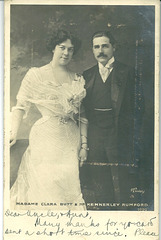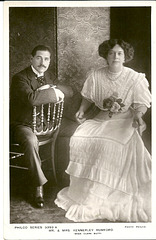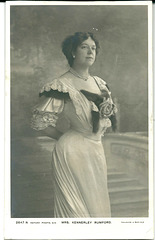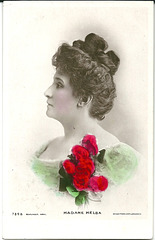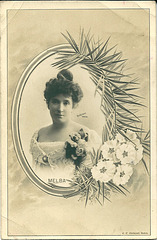OperaMania's photos
Ada Crossley
| |
|
ADA CROSSLEY
(3 May 1871-17 October1929)
Australian Contralto
Studied Melbourne with Fanny Simonsen , First stage appearance 1889 in Melbourne concert . Went to London for further study with Sir Charles Santley and in Paris with mathilde Marchesi. Concert and Oratorio singer never appeared in opera
Clara Butt
| |
|
Clara Butt
1872-1936
English Contralto
Studied with Daniel Rootham in Bristol and John Hnery Blower at The Royal Academy of Music and also took studied in Paris with Jacques Bouhy ,and Etelka Gerster in Berlin and Italy.professional debut at Royal Albert Hall in “the Golden Legend” by Sullivan in 1895.She performed mostly in concert and Oratario. Her only Covent Garden performace was as Orfeo in “Orfeo et Euridice” by Gluck in 1920. Her voice, both powerful and deep, impressed contemporary composers such as Saint-Saëns and Elgar; the latter composed a song-cycle with her in mind as soloist. Camille Saint-Saëns heard her, and wanted her to study his opera Dalila, but at the time the representation of biblical subjects on the British stage was forbidden, and nothing came of it.Later in her career she frequently appeared in recitals together with her husband, the baritone Kennerley Rumford
Ada Crossley
| |
|
ADA CROSSLEY
(3 May 1871-17 October1929)
Australian Contralto
Studied Melbourne with Fanny Simonsen , First stage appearance 1889 in Melbourne concert . Went to London for further study with Sir Charles Santley and in Paris with mathilde Marchesi. Concert and Oratorio singer never appeared in opera
Clara Butt
| |
|
Clara Butt
1872-1936
English Contralto
Studied with Daniel Rootham in Bristol and John Hnery Blower at The Royal Academy of Music and also took studied in Paris with Jacques Bouhy ,and Etelka Gerster in Berlin and Italy.professional debut at Royal Albert Hall in “the Golden Legend” by Sullivan in 1895.She performed mostly in concert and Oratario. Her only Covent Garden performace was as Orfeo in “Orfeo et Euridice” by Gluck in 1920. Her voice, both powerful and deep, impressed contemporary composers such as Saint-Saëns and Elgar; the latter composed a song-cycle with her in mind as soloist. Camille Saint-Saëns heard her, and wanted her to study his opera Dalila, but at the time the representation of biblical subjects on the British stage was forbidden, and nothing came of it.Later in her career she frequently appeared in recitals together with her husband, the baritone Kennerley Rumford
Clara Butt
| |
|
Clara Butt
1872-1936
English Contralto
Studied with Daniel Rootham in Bristol and John Hnery Blower at The Royal Academy of Music and also took studied in Paris with Jacques Bouhy ,and Etelka Gerster in Berlin and Italy.professional debut at Royal Albert Hall in “the Golden Legend” by Sullivan in 1895.She performed mostly in concert and Oratario. Her only Covent Garden performace was as Orfeo in “Orfeo et Euridice” by Gluck in 1920. Her voice, both powerful and deep, impressed contemporary composers such as Saint-Saëns and Elgar; the latter composed a song-cycle with her in mind as soloist. Camille Saint-Saëns heard her, and wanted her to study his opera Dalila, but at the time the representation of biblical subjects on the British stage was forbidden, and nothing came of it.Later in her career she frequently appeared in recitals together with her husband, the baritone Kennerley Rumford
Clara Butt & Kennerley Rumford
| |
|
with daughter Joy Clara Rumford 1901-1976
Robert Henry Kennerley Rumford
1872-1957
English Baritone
Studied with Sbriglia and Jacques Bouhy in Paris and London with Sir George Henschel . he took further study with Blume, Lierhammer and Jean de Reszke.Professional debut was at St James Hall in London in 1896.He sang at the Birmingham and Handel Festivals . He performed in concert and Oratario And made no appearances on the opera stage . Later in his career he frequently appeared in recitals together with his wife, the contralto Clara Butt
Clara Butt
1872-1936
English Contralto
Studied with Daniel Rootham in Bristol and John Hnery Blower at The Royal Academy of Music and also took studied in Paris with Jacques Bouhy ,and Etelka Gerster in Berlin and Italy.professional debut at Royal Albert Hall in “the Golden Legend” by Sullivan in 1895.She performed mostly in concert and Oratario. Her only Covent Garden performace was as Orfeo in “Orfeo et Euridice” by Gluck in 1920. Her voice, both powerful and deep, impressed contemporary composers such as Saint-Saëns and Elgar; the latter composed a song-cycle with her in mind as soloist. Camille Saint-Saëns heard her, and wanted her to study his opera Dalila, but at the time the representation of biblical subjects on the British stage was forbidden, and nothing came of it.Later in her career she frequently appeared in recitals together with her husband, the baritone Kennerley Rumford
Clara Butt & Kennerley Rumford
| |
|
Robert Henry Kennerley Rumford
1872-1957
English Baritone
Studied with Sbriglia and Jacques Bouhy in Paris and London with Sir George Henschel . he took further study with Blume, Lierhammer and Jean de Reszke.Professional debut was at St James Hall in London in 1896.He sang at the Birmingham and Handel Festivals . He performed in concert and Oratario And made no appearances on the opera stage . Later in his career he frequently appeared in recitals together with his wife, the contralto Clara Butt
Clara Butt
1872-1936
English Contralto
Studied with Daniel Rootham in Bristol and John Hnery Blower at The Royal Academy of Music and also took studied in Paris with Jacques Bouhy ,and Etelka Gerster in Berlin and Italy.professional debut at Royal Albert Hall in “the Golden Legend” by Sullivan in 1895.She performed mostly in concert and Oratario. Her only Covent Garden performace was as Orfeo in “Orfeo et Euridice” by Gluck in 1920. Her voice, both powerful and deep, impressed contemporary composers such as Saint-Saëns and Elgar; the latter composed a song-cycle with her in mind as soloist. Camille Saint-Saëns heard her, and wanted her to study his opera Dalila, but at the time the representation of biblical subjects on the British stage was forbidden, and nothing came of it.Later in her career she frequently appeared in recitals together with her husband, the baritone Kennerley Rumford
Clara Butt & Kennerley Rumford
| |
|
Robert Henry Kennerley Rumford
1872-1957
English Baritone
Studied with Sbriglia and Jacques Bouhy in Paris and London with Sir George Henschel . he took further study with Blume, Lierhammer and Jean de Reszke.Professional debut was at St James Hall in London in 1896.He sang at the Birmingham and Handel Festivals . He performed in concert and Oratario And made no appearances on the opera stage . Later in his career he frequently appeared in recitals together with his wife, the contralto Clara Butt
Clara Butt
1872-1936
English Contralto
Studied with Daniel Rootham in Bristol and John Hnery Blower at The Royal Academy of Music and also took studied in Paris with Jacques Bouhy ,and Etelka Gerster in Berlin and Italy.professional debut at Royal Albert Hall in “the Golden Legend” by Sullivan in 1895.She performed mostly in concert and Oratario. Her only Covent Garden performace was as Orfeo in “Orfeo et Euridice” by Gluck in 1920. Her voice, both powerful and deep, impressed contemporary composers such as Saint-Saëns and Elgar; the latter composed a song-cycle with her in mind as soloist. Camille Saint-Saëns heard her, and wanted her to study his opera Dalila, but at the time the representation of biblical subjects on the British stage was forbidden, and nothing came of it.Later in her career she frequently appeared in recitals together with her husband, the baritone Kennerley Rumford
Clara Butt & Kennerley Rumford
| |
|
Robert Henry Kennerley Rumford
1872-1957
English Baritone
Studied with Sbriglia and Jacques Bouhy in Paris and London with Sir George Henschel . he took further study with Blume, Lierhammer and Jean de Reszke.Professional debut was at St James Hall in London in 1896.He sang at the Birmingham and Handel Festivals . He performed in concert and Oratario And made no appearances on the opera stage . Later in his career he frequently appeared in recitals together with his wife, the contralto Clara Butt
Clara Butt
1872-1936
English Contralto
Studied with Daniel Rootham in Bristol and John Hnery Blower at The Royal Academy of Music and also took studied in Paris with Jacques Bouhy ,and Etelka Gerster in Berlin and Italy.professional debut at Royal Albert Hall in “the Golden Legend” by Sullivan in 1895.She performed mostly in concert and Oratario. Her only Covent Garden performace was as Orfeo in “Orfeo et Euridice” by Gluck in 1920. Her voice, both powerful and deep, impressed contemporary composers such as Saint-Saëns and Elgar; the latter composed a song-cycle with her in mind as soloist. Camille Saint-Saëns heard her, and wanted her to study his opera Dalila, but at the time the representation of biblical subjects on the British stage was forbidden, and nothing came of it.Later in her career she frequently appeared in recitals together with her husband, the baritone Kennerley Rumford
Clara Butt
| |
|
Clara Butt
1872-1936
English Contralto
Studied with Daniel Rootham in Bristol and John Hnery Blower at The Royal Academy of Music and also took studied in Paris with Jacques Bouhy ,and Etelka Gerster in Berlin and Italy.professional debut at Royal Albert Hall in “the Golden Legend” by Sullivan in 1895.She performed mostly in concert and Oratario. Her only Covent Garden performace was as Orfeo in “Orfeo et Euridice” by Gluck in 1920. Her voice, both powerful and deep, impressed contemporary composers such as Saint-Saëns and Elgar; the latter composed a song-cycle with her in mind as soloist. Camille Saint-Saëns heard her, and wanted her to study his opera Dalila, but at the time the representation of biblical subjects on the British stage was forbidden, and nothing came of it.Later in her career she frequently appeared in recitals together with her husband, the baritone Kennerley Rumford
Nellie Melba
| |
|
Dame NELLIE MELBA GBE
(Helen Porter Mitchell)
(19 May 1861 – 23 February 1931),
Australian Soprano
Melba was taught to play the piano and first sang in public around age six.She was educated at a local boarding school and then at the Presbyterian Ladies' College. She studied singing with Mary Ellen Christian (a former pupil of Manuel García) and Pietro Cecchi, an Italian tenor, who was a respected teacher in Melbourne. In her teens, Melba continued to perform in amateur concerts in and around Melbourne, and she played the organ at church. Making her professional debut in Melbourne concerts in 1884. On the strength of local success, she travelled to London in search of an opportunity.Her debut at the Princes' Hall in 1886 made little impression, and she sought work unsuccessfully from Sir Arthur Sullivan, Carl Rosa and Augustus Harris.She then went to Paris to study with the leading teacher Mathilde Marchesi, who instantly recognised the young singer's potential: Melba made such rapid progress that she was allowed to sing the "Mad Scene" from Ambroise Thomas's Hamlet at a matinée musicale in Marchesi's house in December the same year, in the presence of the composer.Her talent was so evident that, after less than a year with Marchesi, the impresario Maurice Strakosch gave her a ten-year contract at 1000 francs annually. After she had signed, she received a far better offer of 3000 francs per month from the Théâtre de la Monnaie, Brussels, but Strakosch would not release her and obtained an injunction preventing her from performing .The matter was resolved by Strakosch's sudden death.She made her operatic debut four days later as Gilda in Rigoletto at La Monnaie on 12 October 1887.. It was at this time, on Marchesi's advice, that she adopted the stage name of "Melba", a contraction of the name of her home city.Her Covent Garden début in May 1888, in the title role in Lucia di Lammermoor. She received a friendly but not excited reception The following year, she performed at the Opéra in Paris, in the role of Ophélie in Hamlet; She travelled across Europe to St Petersburg to sing for Tsar Nicholas II: and sang in Paris, Brussels, Vienna , Milan, and Berlin Melba sang the role of Nedda in Pagliacci at Covent Garden in 1893, soon after its Italian premiere. The composer was present, and said that the role had never been so well played before.[19] In December of that year, Melba sang at the Metropolitan Opera in New York for the first time. As at her Covent Garden debut, she appeared as Lucia di Lammermoor, Her Roles included mostly in the lyric soprano repertoire, but with some heavier roles also. She sang the title roles in Herman Bemberg's Elaine and Arthur Goring Thomas's Esmeralda. Her Italian parts included Gilda in Rigoletto, the title role in Aida Desdemona in Otello, Luisa in Mascagni's I Rantzau, Nedda in Pagliacci, Rosina in The Barber of Seville, Violetta in La traviata, and Mimi in La bohème. In the French repertoire, she sang Juliette in Roméo et Juliette, Marguerite in Faust, Marguerite de Valois in Les Huguenots, the title role in Saint-Saëns's Hélène, which was written for her, and Micaëla in Carmen.
Nellie Melba
| |
|
Dame NELLIE MELBA GBE
(Helen Porter Mitchell)
(19 May 1861 – 23 February 1931),
Australian Soprano
Melba was taught to play the piano and first sang in public around age six.She was educated at a local boarding school and then at the Presbyterian Ladies' College. She studied singing with Mary Ellen Christian (a former pupil of Manuel García) and Pietro Cecchi, an Italian tenor, who was a respected teacher in Melbourne. In her teens, Melba continued to perform in amateur concerts in and around Melbourne, and she played the organ at church. Making her professional debut in Melbourne concerts in 1884. On the strength of local success, she travelled to London in search of an opportunity.Her debut at the Princes' Hall in 1886 made little impression, and she sought work unsuccessfully from Sir Arthur Sullivan, Carl Rosa and Augustus Harris.She then went to Paris to study with the leading teacher Mathilde Marchesi, who instantly recognised the young singer's potential: Melba made such rapid progress that she was allowed to sing the "Mad Scene" from Ambroise Thomas's Hamlet at a matinée musicale in Marchesi's house in December the same year, in the presence of the composer.Her talent was so evident that, after less than a year with Marchesi, the impresario Maurice Strakosch gave her a ten-year contract at 1000 francs annually. After she had signed, she received a far better offer of 3000 francs per month from the Théâtre de la Monnaie, Brussels, but Strakosch would not release her and obtained an injunction preventing her from performing .The matter was resolved by Strakosch's sudden death.She made her operatic debut four days later as Gilda in Rigoletto at La Monnaie on 12 October 1887.. It was at this time, on Marchesi's advice, that she adopted the stage name of "Melba", a contraction of the name of her home city.Her Covent Garden début in May 1888, in the title role in Lucia di Lammermoor. She received a friendly but not excited reception The following year, she performed at the Opéra in Paris, in the role of Ophélie in Hamlet; She travelled across Europe to St Petersburg to sing for Tsar Nicholas II: and sang in Paris, Brussels, Vienna , Milan, and Berlin Melba sang the role of Nedda in Pagliacci at Covent Garden in 1893, soon after its Italian premiere. The composer was present, and said that the role had never been so well played before.[19] In December of that year, Melba sang at the Metropolitan Opera in New York for the first time. As at her Covent Garden debut, she appeared as Lucia di Lammermoor, Her Roles included mostly in the lyric soprano repertoire, but with some heavier roles also. She sang the title roles in Herman Bemberg's Elaine and Arthur Goring Thomas's Esmeralda. Her Italian parts included Gilda in Rigoletto, the title role in Aida Desdemona in Otello, Luisa in Mascagni's I Rantzau, Nedda in Pagliacci, Rosina in The Barber of Seville, Violetta in La traviata, and Mimi in La bohème. In the French repertoire, she sang Juliette in Roméo et Juliette, Marguerite in Faust, Marguerite de Valois in Les Huguenots, the title role in Saint-Saëns's Hélène, which was written for her, and Micaëla in Carmen.
Nellie Melba
| |
|
Dame NELLIE MELBA GBE
(Helen Porter Mitchell)
(19 May 1861 – 23 February 1931),
Australian Soprano
Melba was taught to play the piano and first sang in public around age six.She was educated at a local boarding school and then at the Presbyterian Ladies' College. She studied singing with Mary Ellen Christian (a former pupil of Manuel García) and Pietro Cecchi, an Italian tenor, who was a respected teacher in Melbourne. In her teens, Melba continued to perform in amateur concerts in and around Melbourne, and she played the organ at church. Making her professional debut in Melbourne concerts in 1884. On the strength of local success, she travelled to London in search of an opportunity.Her debut at the Princes' Hall in 1886 made little impression, and she sought work unsuccessfully from Sir Arthur Sullivan, Carl Rosa and Augustus Harris.She then went to Paris to study with the leading teacher Mathilde Marchesi, who instantly recognised the young singer's potential: Melba made such rapid progress that she was allowed to sing the "Mad Scene" from Ambroise Thomas's Hamlet at a matinée musicale in Marchesi's house in December the same year, in the presence of the composer.Her talent was so evident that, after less than a year with Marchesi, the impresario Maurice Strakosch gave her a ten-year contract at 1000 francs annually. After she had signed, she received a far better offer of 3000 francs per month from the Théâtre de la Monnaie, Brussels, but Strakosch would not release her and obtained an injunction preventing her from performing .The matter was resolved by Strakosch's sudden death.She made her operatic debut four days later as Gilda in Rigoletto at La Monnaie on 12 October 1887.. It was at this time, on Marchesi's advice, that she adopted the stage name of "Melba", a contraction of the name of her home city.Her Covent Garden début in May 1888, in the title role in Lucia di Lammermoor. She received a friendly but not excited reception The following year, she performed at the Opéra in Paris, in the role of Ophélie in Hamlet; She travelled across Europe to St Petersburg to sing for Tsar Nicholas II: and sang in Paris, Brussels, Vienna , Milan, and Berlin Melba sang the role of Nedda in Pagliacci at Covent Garden in 1893, soon after its Italian premiere. The composer was present, and said that the role had never been so well played before.[19] In December of that year, Melba sang at the Metropolitan Opera in New York for the first time. As at her Covent Garden debut, she appeared as Lucia di Lammermoor, Her Roles included mostly in the lyric soprano repertoire, but with some heavier roles also. She sang the title roles in Herman Bemberg's Elaine and Arthur Goring Thomas's Esmeralda. Her Italian parts included Gilda in Rigoletto, the title role in Aida Desdemona in Otello, Luisa in Mascagni's I Rantzau, Nedda in Pagliacci, Rosina in The Barber of Seville, Violetta in La traviata, and Mimi in La bohème. In the French repertoire, she sang Juliette in Roméo et Juliette, Marguerite in Faust, Marguerite de Valois in Les Huguenots, the title role in Saint-Saëns's Hélène, which was written for her, and Micaëla in Carmen.
Nellie Melba
| |
|
Dame NELLIE MELBA GBE
(Helen Porter Mitchell)
(19 May 1861 – 23 February 1931),
Australian Soprano
Melba was taught to play the piano and first sang in public around age six.She was educated at a local boarding school and then at the Presbyterian Ladies' College. She studied singing with Mary Ellen Christian (a former pupil of Manuel García) and Pietro Cecchi, an Italian tenor, who was a respected teacher in Melbourne. In her teens, Melba continued to perform in amateur concerts in and around Melbourne, and she played the organ at church. Making her professional debut in Melbourne concerts in 1884. On the strength of local success, she travelled to London in search of an opportunity.Her debut at the Princes' Hall in 1886 made little impression, and she sought work unsuccessfully from Sir Arthur Sullivan, Carl Rosa and Augustus Harris.She then went to Paris to study with the leading teacher Mathilde Marchesi, who instantly recognised the young singer's potential: Melba made such rapid progress that she was allowed to sing the "Mad Scene" from Ambroise Thomas's Hamlet at a matinée musicale in Marchesi's house in December the same year, in the presence of the composer.Her talent was so evident that, after less than a year with Marchesi, the impresario Maurice Strakosch gave her a ten-year contract at 1000 francs annually. After she had signed, she received a far better offer of 3000 francs per month from the Théâtre de la Monnaie, Brussels, but Strakosch would not release her and obtained an injunction preventing her from performing .The matter was resolved by Strakosch's sudden death.She made her operatic debut four days later as Gilda in Rigoletto at La Monnaie on 12 October 1887.. It was at this time, on Marchesi's advice, that she adopted the stage name of "Melba", a contraction of the name of her home city.Her Covent Garden début in May 1888, in the title role in Lucia di Lammermoor. She received a friendly but not excited reception The following year, she performed at the Opéra in Paris, in the role of Ophélie in Hamlet; She travelled across Europe to St Petersburg to sing for Tsar Nicholas II: and sang in Paris, Brussels, Vienna , Milan, and Berlin Melba sang the role of Nedda in Pagliacci at Covent Garden in 1893, soon after its Italian premiere. The composer was present, and said that the role had never been so well played before.[19] In December of that year, Melba sang at the Metropolitan Opera in New York for the first time. As at her Covent Garden debut, she appeared as Lucia di Lammermoor, Her Roles included mostly in the lyric soprano repertoire, but with some heavier roles also. She sang the title roles in Herman Bemberg's Elaine and Arthur Goring Thomas's Esmeralda. Her Italian parts included Gilda in Rigoletto, the title role in Aida Desdemona in Otello, Luisa in Mascagni's I Rantzau, Nedda in Pagliacci, Rosina in The Barber of Seville, Violetta in La traviata, and Mimi in La bohème. In the French repertoire, she sang Juliette in Roméo et Juliette, Marguerite in Faust, Marguerite de Valois in Les Huguenots, the title role in Saint-Saëns's Hélène, which was written for her, and Micaëla in Carmen.
Nellie Melba
| |
|
Dame NELLIE MELBA GBE
(Helen Porter Mitchell)
(19 May 1861 – 23 February 1931),
Australian Soprano
Melba was taught to play the piano and first sang in public around age six.She was educated at a local boarding school and then at the Presbyterian Ladies' College. She studied singing with Mary Ellen Christian (a former pupil of Manuel García) and Pietro Cecchi, an Italian tenor, who was a respected teacher in Melbourne. In her teens, Melba continued to perform in amateur concerts in and around Melbourne, and she played the organ at church. Making her professional debut in Melbourne concerts in 1884. On the strength of local success, she travelled to London in search of an opportunity.Her debut at the Princes' Hall in 1886 made little impression, and she sought work unsuccessfully from Sir Arthur Sullivan, Carl Rosa and Augustus Harris.She then went to Paris to study with the leading teacher Mathilde Marchesi, who instantly recognised the young singer's potential: Melba made such rapid progress that she was allowed to sing the "Mad Scene" from Ambroise Thomas's Hamlet at a matinée musicale in Marchesi's house in December the same year, in the presence of the composer.Her talent was so evident that, after less than a year with Marchesi, the impresario Maurice Strakosch gave her a ten-year contract at 1000 francs annually. After she had signed, she received a far better offer of 3000 francs per month from the Théâtre de la Monnaie, Brussels, but Strakosch would not release her and obtained an injunction preventing her from performing .The matter was resolved by Strakosch's sudden death.She made her operatic debut four days later as Gilda in Rigoletto at La Monnaie on 12 October 1887.. It was at this time, on Marchesi's advice, that she adopted the stage name of "Melba", a contraction of the name of her home city.Her Covent Garden début in May 1888, in the title role in Lucia di Lammermoor. She received a friendly but not excited reception The following year, she performed at the Opéra in Paris, in the role of Ophélie in Hamlet; She travelled across Europe to St Petersburg to sing for Tsar Nicholas II: and sang in Paris, Brussels, Vienna , Milan, and Berlin Melba sang the role of Nedda in Pagliacci at Covent Garden in 1893, soon after its Italian premiere. The composer was present, and said that the role had never been so well played before.[19] In December of that year, Melba sang at the Metropolitan Opera in New York for the first time. As at her Covent Garden debut, she appeared as Lucia di Lammermoor, Her Roles included mostly in the lyric soprano repertoire, but with some heavier roles also. She sang the title roles in Herman Bemberg's Elaine and Arthur Goring Thomas's Esmeralda. Her Italian parts included Gilda in Rigoletto, the title role in Aida Desdemona in Otello, Luisa in Mascagni's I Rantzau, Nedda in Pagliacci, Rosina in The Barber of Seville, Violetta in La traviata, and Mimi in La bohème. In the French repertoire, she sang Juliette in Roméo et Juliette, Marguerite in Faust, Marguerite de Valois in Les Huguenots, the title role in Saint-Saëns's Hélène, which was written for her, and Micaëla in Carmen.
Hermine Bosetti
| |
|
Hermine Bosetti
1875-1936
German Soprano
Studied with Jager-Wilczek .Debut at Wiesbaden as Aunchen in “ Der Freischutz’ BY Wber and remained for 4 seasons before going to Vienna .From 1901-1924 she was a principal at the Munich opera She made guest appearances at Covent Garden London 1905,1907 7 1913 After her retirement she taught singing in Frankfurt and later Munich , Her roles included Rosina ‘Barber of Saville” , Eva ‘ Die Meistersanger” , Norina ‘Don Paquale” , Zerbinetta “Ariadne auf Naxos” and Octavian “Der Rosenkavalier”
Herman Winklemann by Krziwanek
| |
|
as Tristan in "Tristan & Isolde" by Wagner
HERMAN WINKLEMANN
(8 March 1849 – 18 January 1912)
German Tenor
He went to Paris to study piano construction, but while there he decided to become a singer. He had his initial training in Paris, and later with Koch in Hanover. Made his debut as Manrico in Verdi's Il trovatore in the Court Theatre of Sondershausen in 1875.He created Anton Rubinstein's Néron , title role of Parsifal at the Bayreuth Festspielhaus in 1882.He was the first Tristan in Vienna (1883), and also the first Otello in that city, where he remained until 1906
Theodor Reichmann by Krziwanek
| |
|
THEODOR REICHMANN
15 March 1849 -22 May 1903
German Baritone
Studied Berlin and Milan . Debuted 1869 (as Ottokar in "Der Freischütz") in Magdeburg .After engagements in Rotterdam (1870-1871), Cologne (1871/1872), Strasbourg (1872) and Hamburg (1872-1875), belonged to 1875-1883 the Munich Court Theatre on and came on April 5, 1881, as a guest at the Hofoper (René in "Masked ball").Debut on June 4 as Dutchman April 8 , 1889 , and from 1 September 1895 until 22 May 1903 Reichmann was a member of the Court Opera , Roles Dutchman , Hans Sachs , Wotan , Don Juan , Count Almaviva , Amonasro , Escamillo , Rigoletto .Sang regularly at the Bayreuth Festival







